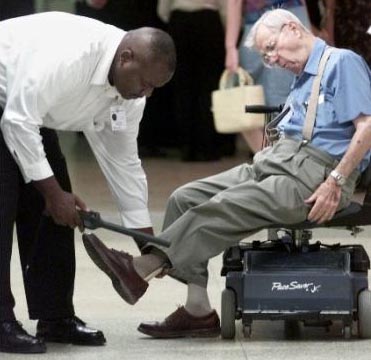
By Craig Torres
May 15 (Bloomberg) -- Federal Reserve officials raised concerns about deflation as early as November 2001, about a year-and-a-half before they disclosed to the public that interest-rate policy was responding to ``an unwelcome'' fall in inflation.
``I think we are moving gradually from a disinflationary process toward a situation where we could experience outright deflation,'' then-Chairman Alan Greenspan told the Federal Open Market Committee meeting that month, according to transcripts released today in Washington.
The comments by Greenspan and others marked a turning point in U.S. monetary history. For years, Fed officials had aimed at squeezing inflation lower over time. Now, they were concerned about inflation falling too low, a condition that could hamper policy operations, disrupt money markets, and compress corporate profits as inventory values fell.
``Economic slack could reduce inflation and inflation expectations so far that it became impossible for the Federal Reserve to drive real interest rates far enough in negative territory to counteract continuing weakness,'' Donald Kohn, then a senior policy adviser, told the committee. Kohn is now the Fed's vice chairman.
During 2001, the FOMC engaged in the most aggressive monetary easing in Greenspan's 18-year tenure, slashing the benchmark lending rate from 6.50 percent to 1.75 percent. Adjusted for inflation, minus food and energy, the benchmark rate fell below zero in November and remained around zero or below until 2005.
Half-Point Steps
Eight of the 11 rate cuts were in half-point moves, and three of those were conducted between meetings as officials received fresh reports of the economy deteriorating more rapidly than they expected. The economic outlook was complicated by the Sept. 11 terrorist attacks on New York and Washington.
The unemployment rate rose 1.5 percentage points during the year as non-farm payrolls shrank for 10 consecutive months after a gain of 80,000 jobs in February. Inventories were flat or negative for 10 months during the year. By the end of the year, factory use rates fell to the lowest levels since 1983.
Fed officials had Japan as a reference point for their worries. The Bank of Japan had cut its benchmark lending rate to zero in 1998 to ward off disinflation. Still, Japan's consumer price index was negative for five consecutive years starting in 1999.
By August 2001, Fed officials had seen the core personal consumption expenditures index fall below 1 percent on a three- month annualized basis for two consecutive months. Their concerns about the deflationary risks resulted in another half- point cut in the federal funds rate in November, the tenth reduction of the year, to 2 percent.
Broaddus's Alarm
Richmond Fed President J. Alfred Broaddus Jr., whose dissents in favor of higher borrowing costs in 1997 defined him as one of the committee's leading inflation hawks, became an unlikely siren on prices falling too low.
``What we need to do now is to pre-empt disinflation -- as novel as it is to think in those terms -- and do so fairly aggressively to guard against potential problems of the zero bound,'' Broaddus said at the November meeting, referring to the possibility that the benchmark rate would have to be cut to zero if a downward price spiral intensified.
Broaddus was joined in his arguments by Greenspan, Governor Edward Gramlich and Vice Chairman Roger Ferguson Jr., and they were also effective in changing other members' votes.
McDonough's Pond
New York Fed President William McDonough said he walked into the meeting preferring a quarter-point rate cut. Telling a story about how the fish pond in his backyard was routinely raided by neighborhood hawks, he said: ``One of the hawks miraculously turned into a beautiful white dove. I was very confused until I realized that what was even more miraculous was that the dove spoke with a southern accent.''
McDonough changed his vote in support of a 50 basis-point cut. A basis point is 0.01 percentage point.
Two years later, Governor Ben S. Bernanke gave a speech titled: ``Deflation: Making Sure `It' Doesn't Happen Here,'' that described the risks of deflation and the cures a central bank could pursue.
By May 2003, the FOMC cited in its statement ``the probability of an unwelcome substantial fall in inflation'' as the largest risk then shaping monetary policy. The federal funds rate had been cut to 1.25 percent, and would drop to 1 percent the next month with San Francisco Fed President Robert Parry dissenting in favor of a 50-basis point cut.
The monetary stimulus in 2001 helped keep the recession shallow. The National Bureau of Economic Research in Cambridge, Mass., the arbiter of U.S. business cycles, says the 2001 recession lasted eight months from March to November.















